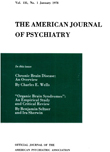GROUP THERAPY FOR MOTHERS WITH INFANTICIDAL IMPULSES
Abstract
This study reports on the clinical experience with a group of mothers with were unique. 2. The patients encouraged infanticidal impulses. The 4 shared, biographical characteristics found were: 1. They have strong feelings of resentment toward their parents for not fulfilling their dependency needs during childhood. 2. One or both of the parents or a significant parental figure was subject to uncontrolled temper outbursts during which the patient was the object of or witness to acts of violence. 3. They had lifelong feelings of rivalry with and hatred for men. Many trace this feeling to intense sibling rivalry with their brothers during childhood. 4. They seek motherly type men for husbands.
Clinically they range from obsessional neurotics to borderline psychotics. Though there is this wide variation in diagnosis, there are a number of symptoms held in common: 1. They have disturbing thoughts about harming their children. The major focus of this aggression is a male child. The gap between the impulse and the act is on a continuum which parallels the diagnostic range. At the obsessional end of the scale the gap is wide and the impulse is alien to the concept of self. At the other end the impulse is felt in full intensity and primitive defenses are used to keep from committing infanticide. 2. They have multiple phobias. Here, too, the adequacy of the phobia as a defense varies on a scale parallel with the diagnostic range. At one extreme, the phobias, like the obsessional thoughts, effectively screen the rejected impulse from consciousness. At the other end of the scale the phobia is related in consciousness to the impulse which it is used to defend against. Throughout the entire range the phobias were crippling symptoms which encouraged progressive withdrawal from social contact. 3. They were depressed. Here too there is a range from vague feelings of hopelessness with unexplained episodes of tearfulness to psychotic depression with marked feelings of guilt, selfdepreciatory ideas and retardation. 4. They were disturbed by suicidal impulses. 5. They were intermittently or chronically frigid.
Group psychotherapy offered a number of therapeutic advantages. 1. The group situation corrected the impression that the murderous impulses that they experienced and supported each other in their efforts to overcome common symptoms such as phobias about riding public transportation. 3. Consensual validation by the group members was helpful in correcting transference distortions. Such observations by group members were less likely to be interpreted as criticisms to be defended against than were observations by the therapist. 4. A mixing of defenses took place. The group members were able to learn different methods of adaptation from each other and to try them out in the group setting. 5. The group meetings provided a meaningful social experience for otherwise isolated people.
Access content
To read the fulltext, please use one of the options below to sign in or purchase access.- Personal login
- Institutional Login
- Sign in via OpenAthens
- Register for access
-
Please login/register if you wish to pair your device and check access availability.
Not a subscriber?
PsychiatryOnline subscription options offer access to the DSM-5 library, books, journals, CME, and patient resources. This all-in-one virtual library provides psychiatrists and mental health professionals with key resources for diagnosis, treatment, research, and professional development.
Need more help? PsychiatryOnline Customer Service may be reached by emailing [email protected] or by calling 800-368-5777 (in the U.S.) or 703-907-7322 (outside the U.S.).



